Development of Electrode of Electric Impulse Chamber for Coal Grinding
Abstract
1. Introduction
2. Experimental Installation and Research Methodology
- Control block for monitoring the operating modes of the installation (see Figure 1);
- Generator for converting AC voltage at the input into DC voltage at the output;
- Capacitor for energy storage;
- Protection system for switching off the installation in cases when the voltage on the capacitor exceeds the established safe working voltage of the discharge;
- Spark gap (forming gap) consisting of two conductive hemispherical electrodes separated by an air gap designed to form an electric spark between the conductors;
- Working chamber for grinding coal.
3. Results and Discussion
3.1. The Test Results of the Positive Electrode
- Sample № 1—the outer part of the front end of the positive electrode is completely insulated with fluoroplastic;
- Sample № 2—the presence of a space between the insulation and the electrode, as well as a 1.5 times reduction of the diameter of the front end of the electrode compared with its main diameter.
- by increasing the insulation diameter 4 times relative to the metal electrode diameter (D = 4 × d), an effective working electrode variant, resistant to electric impulse discharge impact, was achieved;
- based on the experimental results, a possible saving in insulation material was observed compared to sample № 1.
- The liquid (technical water) in the space between the electrode and the insulation serves as additional insulation and prevents damage to the fluoroplastic.
- The protruding part of the electrode from the insulation diverts streamers from the fluoroplastic. This is explained by the fact that streamers usually grow intensively from the end of the electrode.
- The active surface of the end of the thin electrode protruding far from the insulation, due to its small diameter, does not exceed the active surface of the usually used thick electrode, which slightly protrudes from the insulation [28].
- Thus, the electrode design promotes efficient electric field distribution and reduces the risk of electrical breakdowns in the fluoroplastic insulation. This ensures high electrode reliability under pulsed discharge conditions, protecting the insulating materials from degradation and extending the device’s lifespan [29]. Additionally, this design allows for optimal control of the electrical load and reduces the likelihood of local overheating on the material’s surface, which is a critical factor for system reliability. The use of an electrode with high mechanical strength and thermal resistance, combined with its optimized shape, minimizes energy losses and ensures stable operation under dynamic electric field conditions. Therefore, this electrode design not only extends its service life but also enhances the overall efficiency of the system, ensuring reliable performance under pulsed electrical discharges.
3.2. Grinding of Coal by the Electric Impulse Method
- capacitor capacitance—from 0.25 μF to 1 μF (to increase the electric capacitance of the capacitor, 4 capacitors with the same nominal voltage and capacitance (100 kV, C = 0.25 μF) were connected in parallel);
- pulse discharge voltage—U = 32 kV;
- number of pulse discharges from 250 to 1500;
- electrode sample № 1: electrode insulation diameter, depending on the diameter of the metal electrode—D = 7 × d;
- electrode sample № 2: distance between the metal electrode and its insulation—S = 3 mm; electrode insulation diameter, depending on the diameter of the metal electrode—D = 4 × d.
4. Conclusions
Author Contributions
Funding
Institutional Review Board Statement
Informed Consent Statement
Data Availability Statement
Conflicts of Interest
References
- World Energy Council. World Energy Resources: Coal 2013. 2013. Available online: https://www.worldenergy.org/assets/images/imported/2013/10/WER_2013_1_Coal.pdf (accessed on 1 October 2013).
- IPCC. Climate Change 2007: Synthesis Report. 2007. Available online: https://www.enviro.wiki/images/b/be/2007-IPCC-Climate_change_synthesis_report.pdf (accessed on 1 October 2013).
- IEA. IEA Coal Research: Clean Coal Centre. Advances in Multi-Pollutant Control. 2013. Available online: https://usea.org/sites/default/files/112013_Advances%20in%20multi-pollutant%20control_ccc227.pdf (accessed on 1 October 2013).
- Pudasainee, D.; Kim, J.H.; Yoon, Y.S.; Seo, Y.C. Oxidation, reemission and mass distribution of mercury in bituminous coal fired power plants with SCR, CS-ESP and wet FGD. Fuel 2012, 93, 312–318. [Google Scholar] [CrossRef]
- World Coal Institute. Coal: Liquid Fuels. 2009. Available online: https://web.archive.org/web/20151122232436/http://www.worldcoal.org/sites/default/files/coal_liquid_fuels_report(03_06_2009).pdf (accessed on 1 October 2013).
- Snetkova, I.M. Production Technology and Fuel and Energy Characteristics of Alternative Liquid Coal Fuel; Gornaya Kniga: Moscow, Russia, 2008; pp. 182–189. [Google Scholar]
- Serant, F.A.; Tsepenok, A.I.; Ovchinnikov, Y.V.; Lutsenko, S.V.; Karpov, E.G. Preparation of water-coal fuel and its combustion technologies. Mod. Sci. 2011, 1, 95–101. Available online: https://modern.science.triacon.org/ru/issues/2011/files/papers/1/95-101.pdf (accessed on 1 October 2013).
- Maloletnev, A.S.; Naumov, K.I. Coal-Derived Liquid Fuel; Gornaya Kniga: Moscow Russia, 2014; pp. 227–237. [Google Scholar]
- Zenkov, A.; Sokolova, E.Y. Coal-Water Slurry. Language and World Culture: The View of Young Researchers: Proceedings of the XV All-Russian Scientific and Practical Conference; TPU: Nakano, Tokyo; Toms, Russia, 2016; Volueme 3, pp. 152–157. Available online: https://earchive.tpu.ru/bitstream/11683/32428/1/conference_tpu-2016-C89_V3_p152-157.pdf (accessed on 1 October 2013).
- Ibragimov, N.I.; Mukolyants, A.A.; Ergasheva, D.K.; Babaev, M.S. Research and development of technology for obtaining coal-water suspension based on coal from the Angren coal mine. Young Sci. Ecol. 2017, 8, 103–109. Available online: https://moluch.ru/archive/142/pdf/883/ (accessed on 1 October 2013).
- Bulkairova, G.; Nussupbekov, B.; Bolatbekova, M.; Khassenov, A.; Nussupbekov, U.; Karabekova, D. A research of the effect of an underwater electric explosion on the selectivity of destruction of quartz raw materials. East.-Eur. J. Enterp. Technol. 2023, 3, 30–37. [Google Scholar] [CrossRef]
- Dal Martello, E.; Bernardis, S.; Larsen, R.B.; Tranell, G.; Di Sabatino, M.; Arnberg, L. Electrical fragmentation as a novel route for the refinement of quartz raw materials for trace mineral impurities. Powder Technol. 2012, 224, 209–216. [Google Scholar] [CrossRef]
- Andres, U. Development and prospects of mineral liberation by electrical pulses. Int. J. Miner. Process. 2010, 97, 31–38. [Google Scholar] [CrossRef]
- Sperner, B.; Jonckheere, R.; Pfänder, J.A. Testing the influence of high-voltage mineral liberation on grain size, shape and yield, and on fission track and 40Ar/39Ar dating. Chem. Geol. 2014, 371, 83–95. [Google Scholar] [CrossRef]
- Khassenov, A.; Karabekova, D.; Bolatbekova, M.; Nussupbekov, B.; Kudussov, A.; Chirkova, L.; Kissabekova, P. Identification of the effect of electric impulse discharges on the recycling of household glass. East.-Eur. J. Enterp. Technol. 2024, 2, 6–13. [Google Scholar] [CrossRef]
- Duan, C.L.; Diao, Z.J.; Zhao, Y.M.; Huang, W. Liberation of valuable materials in waste printed circuit boards by high-voltage electrical pulses. Miner. Eng. 2015, 70, 170–177. [Google Scholar] [CrossRef]
- Louis, J.C.; Thomas, O.; Vladimir, N.R. Electric-pulse disaggregation (EPD), Hydroseparation (HS) and their use in combination for mineral processing and advanced characterization of ores. In Proceedings of the 40th Annual Canadian Mineral Processors Conference, Ottawa, ON, Canada, 22–24 January 2008; pp. 211–235. Available online: https://www.researchgate.net/publication/281466029 (accessed on 1 October 2013).
- Kurytnik, I.P.; Khassenov, A.K.; Nussupbekov, U.B.; Karabekova, D.Z.; Nussupbekov, B.R.; Bolatbekova, M. Development of a grinding device for producing coal powder-raw materials of coal-water fuel. Arch. Mech. Eng. 2022, 69, 259–268. [Google Scholar] [CrossRef]
- Robak, J.; Ignasiak, K.; Rejdak, M. Coal micronization studies in vibrating mill in terms of Coal-Water Slurry (CWS) Fuel preparation. J. Ecol. Eng. 2017, 18, 111–118. [Google Scholar] [CrossRef]
- Xiankai, B.; Jiaxing, C.; Wenxiang, Z.; Junyu, G.; Yuan, L.; Jinchang, Z. Study on the damage model of coal rock caused by hydraulic pressure and electrical impulse in borehole. Geofluids 2021, 19, 6627242. [Google Scholar] [CrossRef]
- Zhang, X.; Lin, B.; Li, Y.; Zhu, C. Experimental study on the effect of coal thickness and breakdown voltage on energy conversion during electrical disintegration. Fuel 2020, 259, 116135. [Google Scholar] [CrossRef]
- Zhang, X.; Lin, B.; Li, Y. Experimental study on the effects of electrode materials on coal breaking by plasma. Fuel 2020, 270, 117085. [Google Scholar] [CrossRef]
- Nussupbekov, B.; Khassenov, A.; Nussupbekov, U.; Akhmadiyev, B.; Karabekova, D.; Kutum, B.; Tanasheva, N. Development of technology for obtaining coal-water fuel. East.-Eur. J. Enterp. Technol. 2022, 3, 39–46. [Google Scholar] [CrossRef]
- Krutilin, A.K.; Bestuzhev, Y.K.; Bestuzhev, A.K.; Kalenkovich, D.K. Grinding bodies: Problems and prospects. Repub. Sci. Tech. J. Cast. Metall. 2009, 4, 26–33. Available online: https://cyberleninka.ru/article/n/melyuschie-tela-problemy-perspektivy?utm_source=chatgpt.com (accessed on 1 October 2013).
- Litvinsky, G.G. Impact jaw crusher with hydraulic drive. Mech. Eng. Mach. Sci. 2023, 31, 75–93. Available online: https://cyberleninka.ru/article/n/udarnaya-schekovaya-drobilka-s-gidroprivodom-problemy-i-resheniya?utm_source=chatgpt.com (accessed on 1 October 2013).
- Plashchinsky, V.A.; Beloglazov, I.I.; Akhmerov, E.V. Analysis of the wear model of working elements of a ball mill in the process of ore grinding. MIAB Min. Inform. Anal. Bull. 2024, 7, 91–110. [Google Scholar] [CrossRef]
- Yutkin, L.A. Electrohydraulic Effect and Its Application in Industry; Mechanical Engineering: Leningrad, Russia, 1986; p. 253. [Google Scholar]
- Starkov, N.V. Compact electrode systems of pulsed electrohydraulic (EG) installations. Electron. Process. Mater. 2014, 50, 115–120. Available online: https://cyberleninka.ru/article/n/kompaktnye-elektrodnye-sistemy-impulsnyh-elektrogidravlicheskih-eg-ustanovok/viewer (accessed on 1 October 2013).
- Kurets, V.I.; Soloviev, M.A.; Zhuchkov, A.I.; Barskaya, A.V. Electric Discharge Technologies for Processing and Destruction of Materials; Publishing House of Tomsk Polytechnic University: Tomsk, Russia, 2012. [Google Scholar]
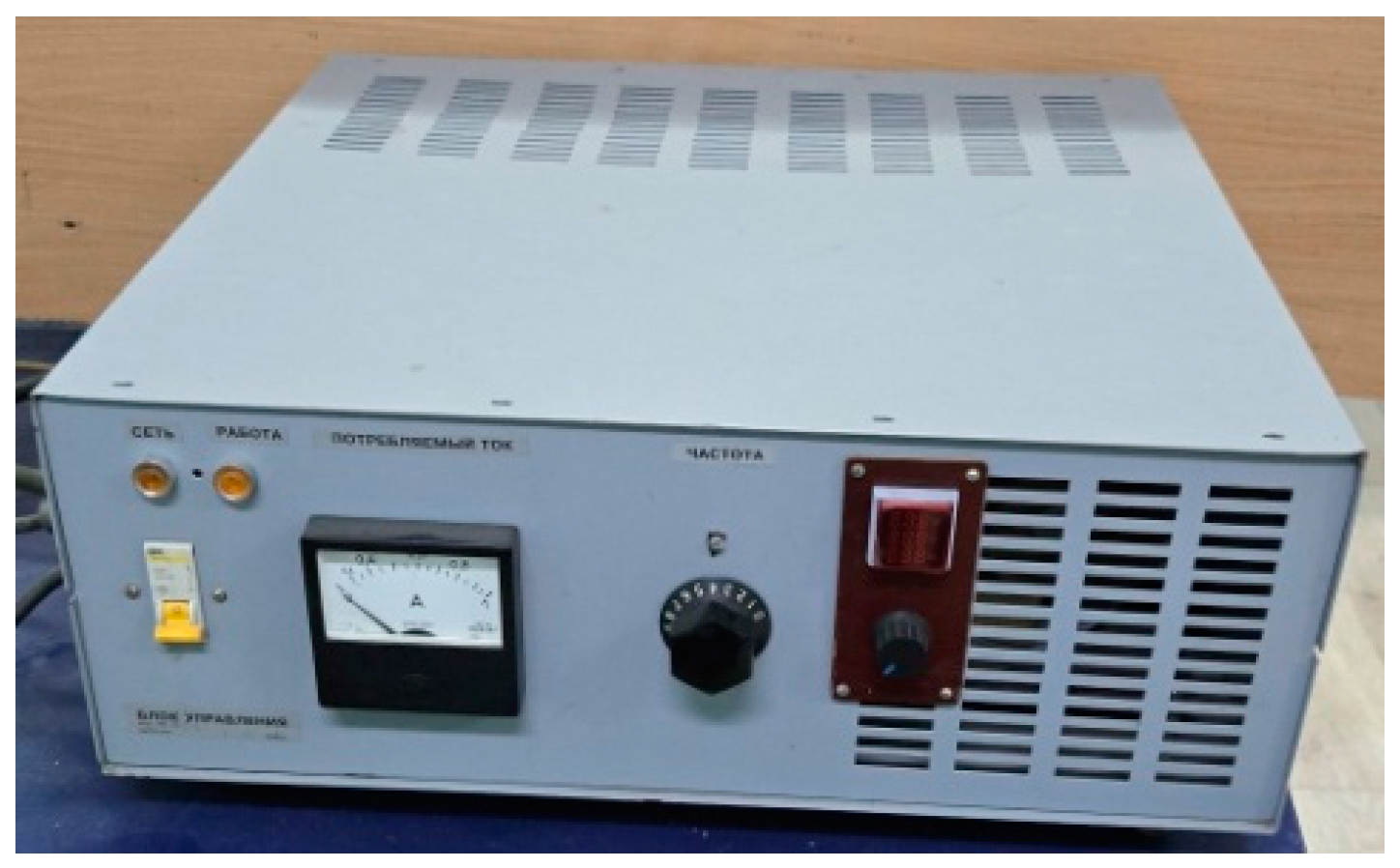

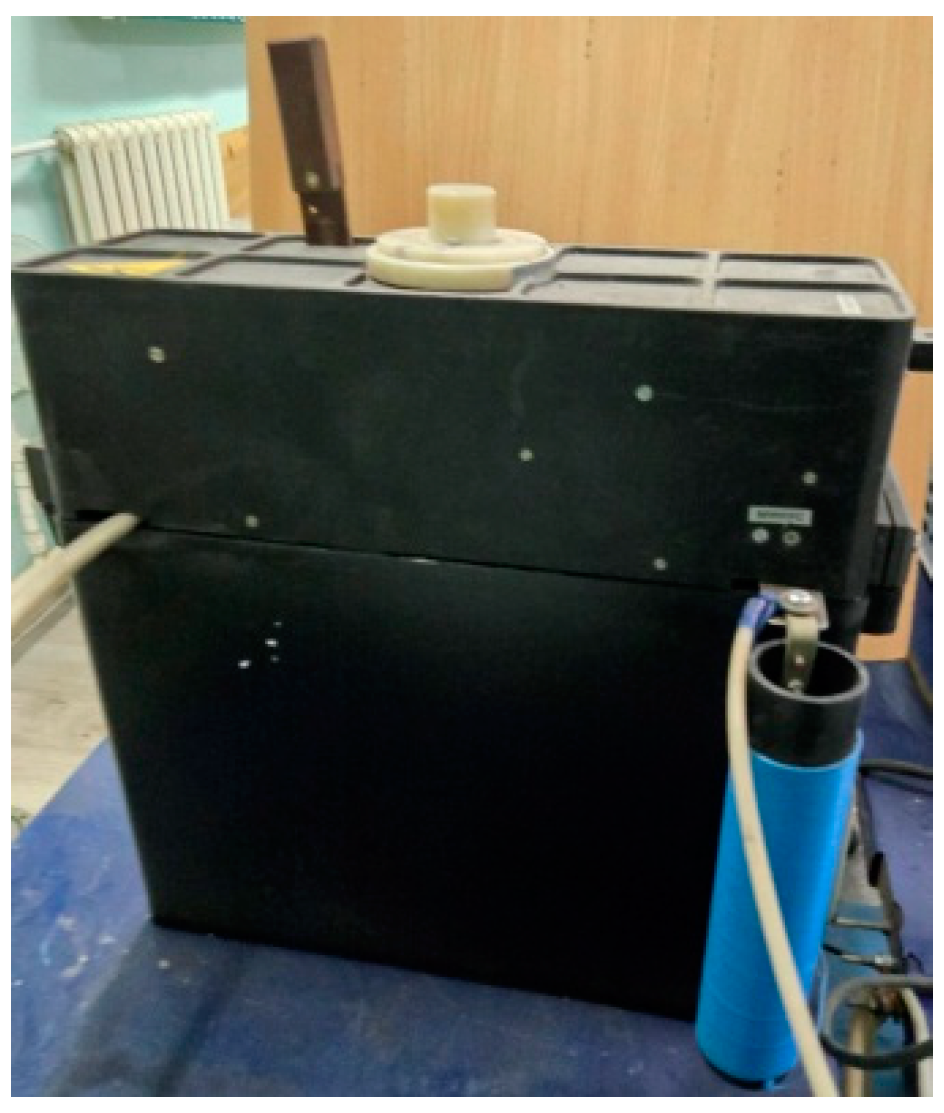
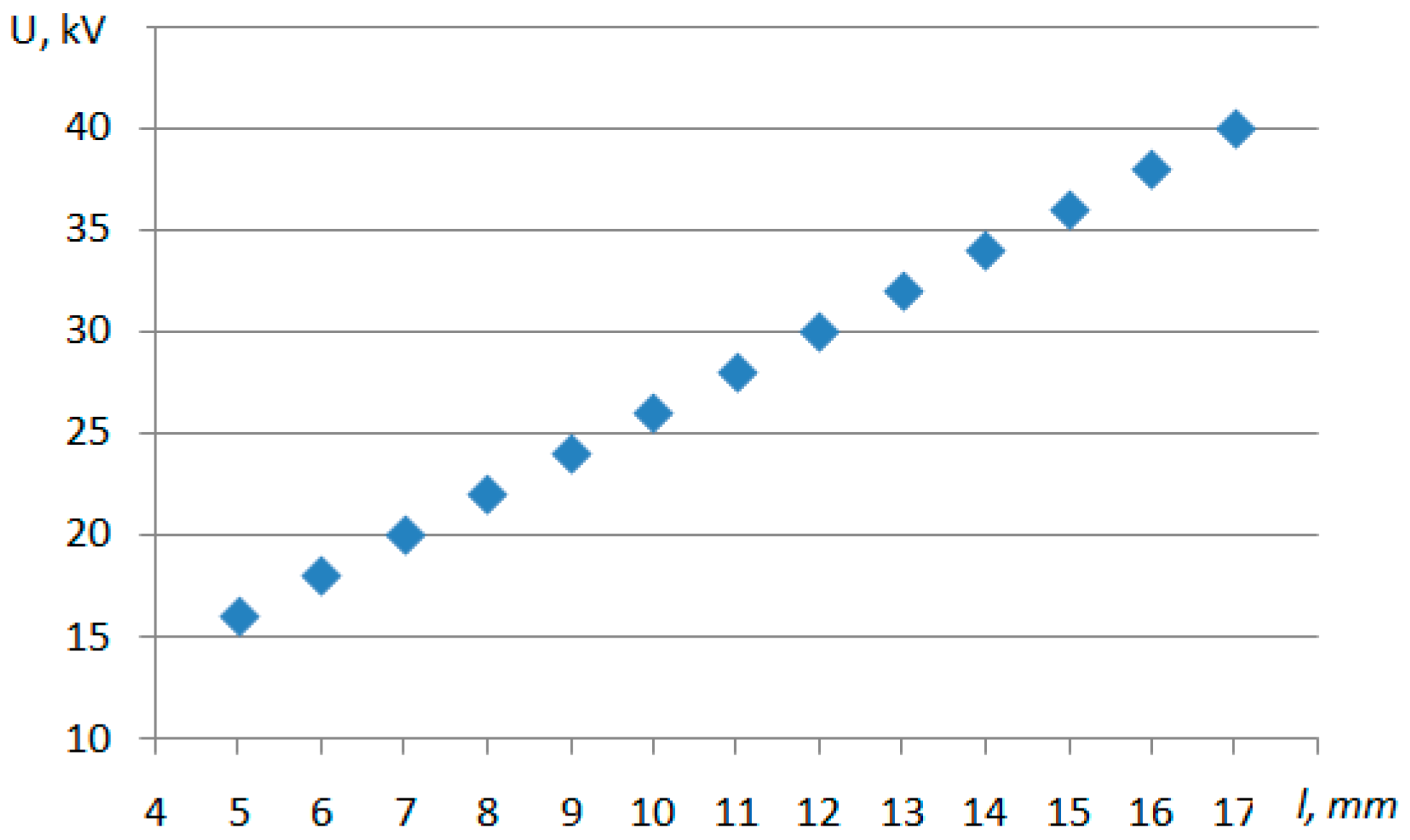
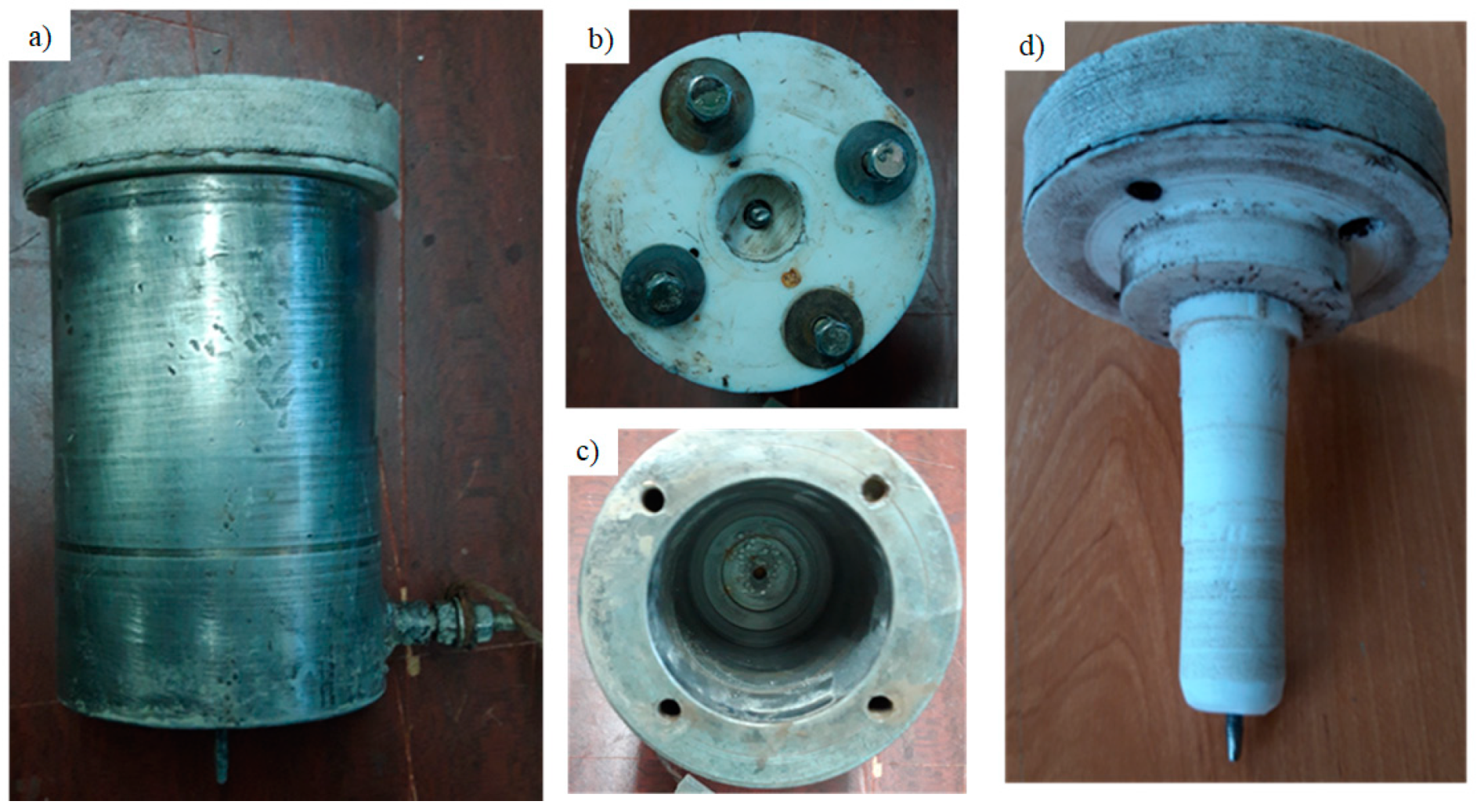
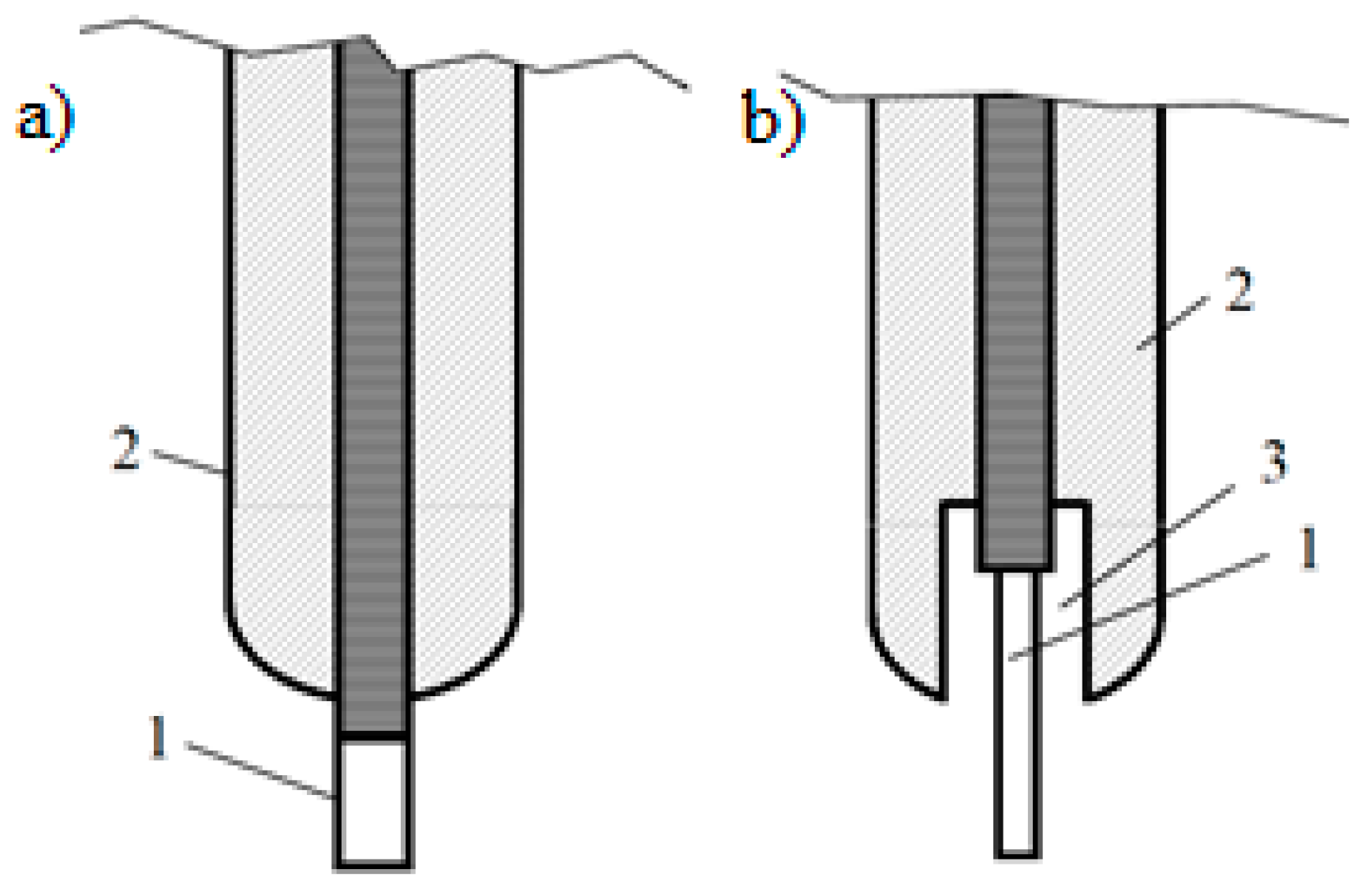
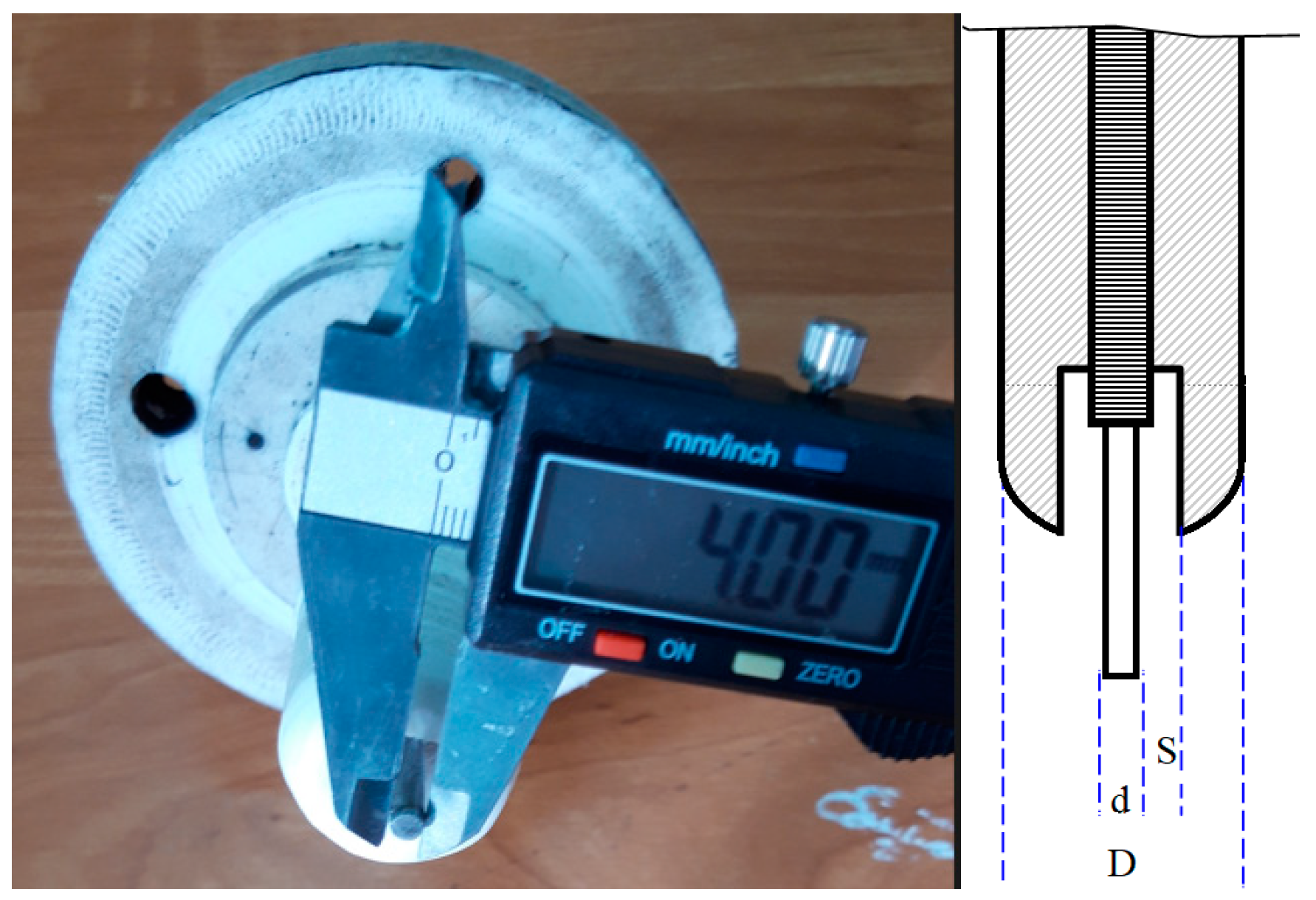
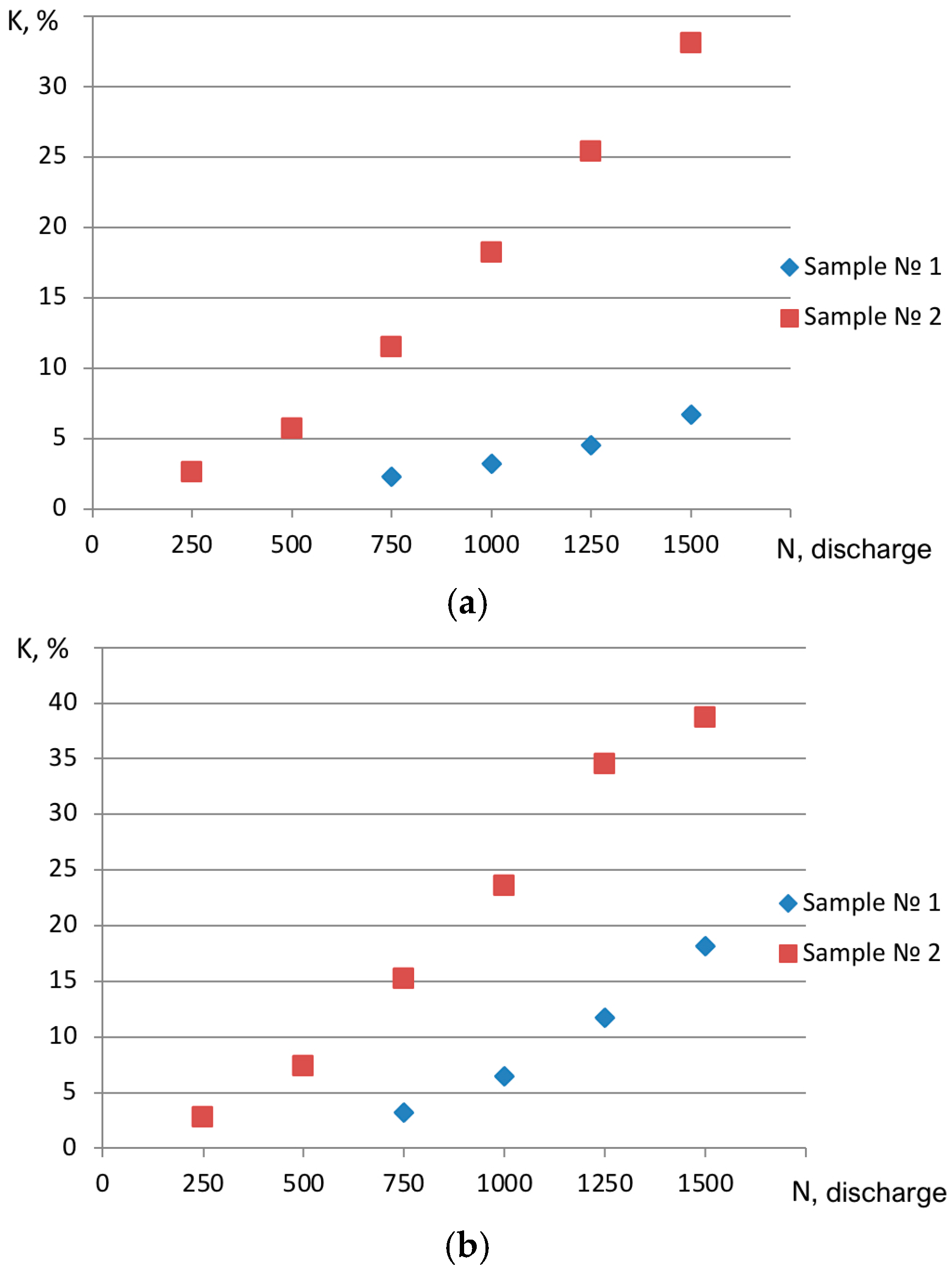

| Working Fluid | Technical Water |
|---|---|
| Power supply network parameters: | |
| Voltage, V | 220 |
| Frequency, Hz | 50 |
| Power consumption, kW | 2.5 |
| N, Discharge | 2000 | 4000 | 6000 | 8000 |
|---|---|---|---|---|
| D = 3 × d, (D = 6 mm) | ||||
| U = 30 kV | + | − | − | − |
| D = 4 × d, (D = 6 mm) | ||||
| U = 30 kV | + | + | − | − |
| D = 5 × d, (D = 6 mm) | ||||
| U = 30 kV | + | + | + | − |
| D = 6 × d, (D = 6 mm) | ||||
| U = 30 kV | + | + | + | + |
| U = 40 kV | + | + | − | − |
| D = 7 × d, (D = 6 mm) | ||||
| U = 30 kV | + | + | + | + |
| U = 40 kV | + | + | + | + |
| N, Discharge | 2000 | 4000 | 6000 | 8000 |
|---|---|---|---|---|
| D = 2 × d, (D = 4 mm) | ||||
| U = 30 kV | + | + | + | + |
| U = 40 kV | − | − | − | − |
| D = 3 × d, (D = 4 mm) | ||||
| U = 30 kV | + | + | + | + |
| U = 40 kV | + | + | − | − |
| D = 4 × d, (D = 4 mm) | ||||
| U = 30 kV | + | + | + | + |
| U = 40 kV | + | + | + | + |
| N, Discharge | 2500 | 5000 | 7500 | 10,000 |
|---|---|---|---|---|
| S = 1 mm | ||||
| U = 30 kV | + | + | + | + |
| U = 40 kV | + | + | − | − |
| U = 50 kV | − | − | − | − |
| S = 2 mm | ||||
| U = 30 kV | + | + | + | + |
| U = 40 kV | + | + | + | + |
| U = 50 kV | + | + | − | − |
| S = 3 mm | ||||
| U = 30 kV | + | + | + | + |
| U = 40 kV | + | + | + | + |
| U = 50 kV | + | + | + | + |
| S = 8 mm | ||||
| U = 30 kV | + | + | + | + |
| U = 40 kV | + | + | + | + |
| U = 50 kV | + | + | + | + |
Disclaimer/Publisher’s Note: The statements, opinions and data contained in all publications are solely those of the individual author(s) and contributor(s) and not of MDPI and/or the editor(s). MDPI and/or the editor(s) disclaim responsibility for any injury to people or property resulting from any ideas, methods, instructions or products referred to in the content. |
© 2025 by the authors. Licensee MDPI, Basel, Switzerland. This article is an open access article distributed under the terms and conditions of the Creative Commons Attribution (CC BY) license (https://creativecommons.org/licenses/by/4.0/).
Share and Cite
Khassenov, A.K.; Karabekova, D.Z.; Bolatbekova, M.M.; Kudussov, A.S.; Kassymov, S.S.; Chirkova, L.V. Development of Electrode of Electric Impulse Chamber for Coal Grinding. Appl. Sci. 2025, 15, 3607. https://doi.org/10.3390/app15073607
Khassenov AK, Karabekova DZ, Bolatbekova MM, Kudussov AS, Kassymov SS, Chirkova LV. Development of Electrode of Electric Impulse Chamber for Coal Grinding. Applied Sciences. 2025; 15(7):3607. https://doi.org/10.3390/app15073607
Chicago/Turabian StyleKhassenov, Ayanbergen Kairbekovich, Dana Zhilkibaevna Karabekova, Madina Muratovna Bolatbekova, Arystan Satybaldinovich Kudussov, Serik S. Kassymov, and Lyubov Vasilyevna Chirkova. 2025. "Development of Electrode of Electric Impulse Chamber for Coal Grinding" Applied Sciences 15, no. 7: 3607. https://doi.org/10.3390/app15073607
APA StyleKhassenov, A. K., Karabekova, D. Z., Bolatbekova, M. M., Kudussov, A. S., Kassymov, S. S., & Chirkova, L. V. (2025). Development of Electrode of Electric Impulse Chamber for Coal Grinding. Applied Sciences, 15(7), 3607. https://doi.org/10.3390/app15073607







